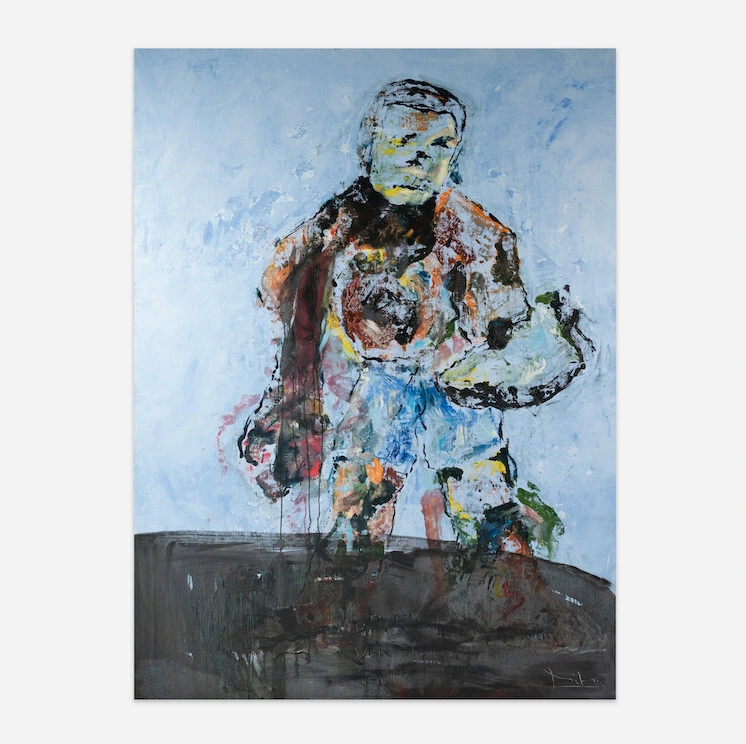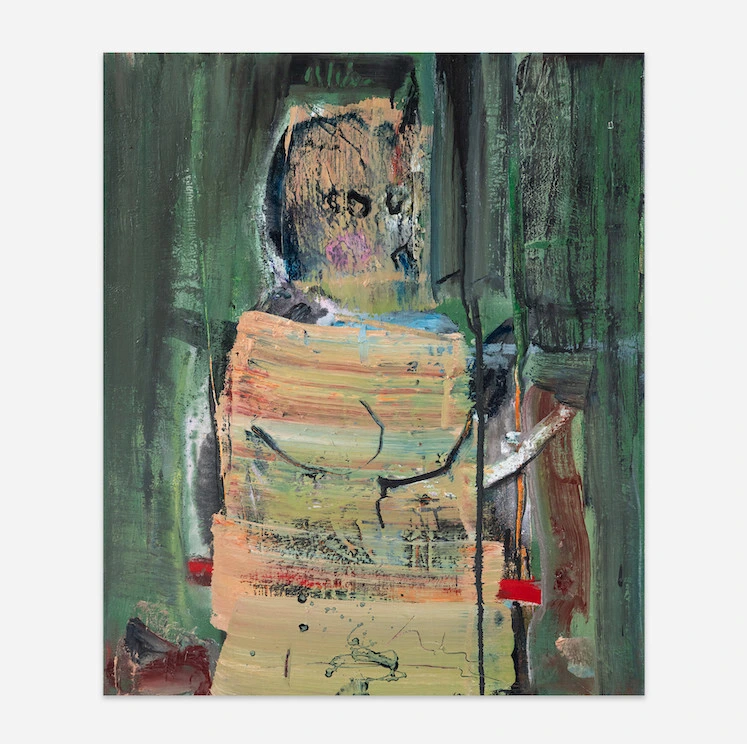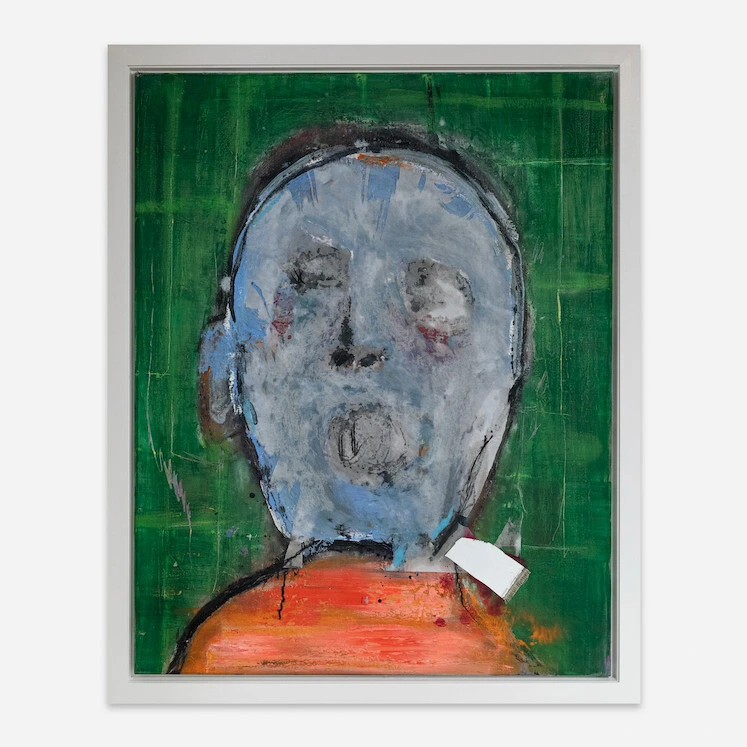1983 / Germany
1992, Marzahn, Berlin: Alexander Dik's family moves to Germany. They are 'Russlanddeutsche' migrants - a problematic German minority in their homeland, Kazakhstan. For Alexander, life has been a hard road since he was very young. Marzahn is far from a rosy neighbourhood - a place where the family lives in the middle of nowhere. the water tastes like blood, as they say around there. Alexander desires only one thing, the one thing he always felt destined to do: painting. But the conservative environment he comes from forbids it. Instead, he becomes a retail salesman for a supermarket chain specialised in Eastern European food and practices taekwondo as an amateur athlete. He continues to paint in secret, finding solace in a clandestine, dark, almost claustrophobic studio in the supermarket's basement.
In 2018, he makes a bold decision: he will be a full-time painter. The following year, at thirty-five, he enrols at the Berlin Academy of Arts, begins to breathe again, and becomes unstoppable. His professor, Andreas Amrhein, writes about him: 'During his studies, Alexander has achieved a lot, tried many things, discarded some, developed a strong artistic stance, and is now moving forward. None of his goals are too distant for him. With his innate energy, he will pursue them.'
His works are bold and unfiltered, much like his city, filled with all its contradictions, its violence, and its wounded, uprooted, and feverish heroes. After years of suppressing his talent, Alexander Dik is now experiencing a working trance. Each morning, he wakes up early and heads to his new studio: a spacious, airy shed in the heart of Brandenburg's countryside. Unlike many artists, he does not suffer from the impasse of facing a blank canvas. For him, the challenge is how to contain the flood of ideas rushing out. He typically works on multiple series at once, often across several canvases simultaneously, both vertically and horizontally. He loves to place a canvas under his feet while he paints, allowing it to collect splashes of colour, the imprints of his steps, and even the ashes of his cigarettes. These 'floor paintings' unintentionally capture the full spectrum of the creative process, from the raw materiality of his movements to the residue of his artistic rituals. For Alexander, they hold equal value to those produced with deliberate intention.
Above all, Alexander Dik is a craftsman. His art, at once neo-expressionist and symbolic, blends a profound mastery of oil paint - his 'true language,' as he calls it - with a relentless drive to experiment with different techniques. He works with brush, spatula, and spray, but his paintings often seem like they had been made by different hands. Few artists work in such a wide range of approaches. At times, he flings paint onto the canvas in dribbled patterns, echoing the energy of Jackson Pollock. At other times, colours fold into mountainous formations, protruding from the surface like fleshy contours. There are moments in which he arranges paint blobs on the canvas, then sweeps them with a wide spatula - just like that, a single move and the work is complete. Yet there are also longer battles, where he stratifies layer over layer, only satisfied when colours magically suck the viewer into their depths. Excitement peaks when he presses one canvas against another, letting the imprint of an ongoing work guide the birth of something new - a process charged with physical intensity and unpredictability.
As a man, he is a fighter, a risk-taker; his choice to be an artist remains scandalous to those who once opposed it. As a painter, he is a defier, a seeker - one who dares to look where others cannot or would rather not. He is, in every sense, an armed poet.
'At three years old, I painted cars with sixteen wheels; they laughed. At nine, I painted forbidden symbols; they punished me. At sixteen, I painted swamps; they said I was crazy. At twenty, I wanted to study art; they forbade it. At thirty-five, I began studying art; they said I was unwell. The fear of others took many years from me. Do not live with the fear of others. Live your dream now and without delay.' - Alexander Dik
In 1992, Berlin Marchan and Alexander Dyck moved to Germany with their family. They were "Russian Germans" (Russlanddeutsche), an ethnic minority in Kazakhstan. For Alexander, life has been a struggle since childhood. Marchan was by no means an ideal neighborhood; people there used to say that "the water tasted like blood". Alexander wanted only one thing: to do the one thing he believed he was destined to do: paint. He worked as a salesman in a chain of supermarkets specializing in Eastern European food and took up taekwondo as a hobby. But he continued to paint in secret. In a dark, stuffy, secret studio in the supermarket's basement, drawing was his only solace.
In 2018, he makes a bold decision. A year later, at the late age of thirty-five, he enrolled at the University of the Arts in Berlin and began to breathe. From then on, his steps never stopped. His professor, Andreas Amrhein, had this to say about him.
"During his studies, Alexander achieved many things and, We've tried a number of different things, Sometimes I threw it away. But he established a strong artistic attitude and, Moving forward. His goal is never too far away for him. With his innate energy, he will pursue his path to the end.."
His work is as bold and unapologetic as the city he lives in. All of the city's contradictions, violence, wounded, uprooted, passionate heroes are reflected in his work. Unleashing a long-suppressed talent, Alexander is currently in the throes of a creative ecstasy. Every morning he rises early and heads to his new, spacious studio in the Brandenburg countryside. Facing a blank canvas is not something he fears. The challenge is how to control the overflow of ideas. He works on several canvases at the same time, blurring the lines between vertical and horizontal. He especially likes to work with the canvas under his feet, so that his steps, paint splatters, and even cigarette ash become part of the work. The resulting "floor paintings" are just as significant as his more deliberate works.
Above all, Alexander Dyck is a master craftsman. His work is a combination of neo-expressionism and symbolism, showing a deep mastery of oil painting, which he calls his "true language," and a willingness to experiment with different techniques. He uses brushes, spatulas, and sprays freely, and sometimes a work looks as if it has passed through several hands. From drip techniques reminiscent of Jackson Pollock, to mountainous layers of color, to moments of completion in a single spatula movement, his paintings are created with a variety of approaches, sometimes pressing one canvas onto another to create a new work. The process is full of unpredictable physical intensity and excitement. Alexander crosses taboos and challenges conventions.
"Three years old, I drew a car with sixteen wheels. They scoffed. Nine years old, You drew a prohibited symbol. They Punished Me. Sixteen years old, Drew a swamp. They said I was crazy. Twenty, I wanted to study art. They banned. Thirty-five, I started studying art. They said I wasn't normal. Other People's Fears Stole a Lot of Time from Me. Don't live in the fear of others. Now, Live your dreams without hesitation."
- Alexander Dyck


